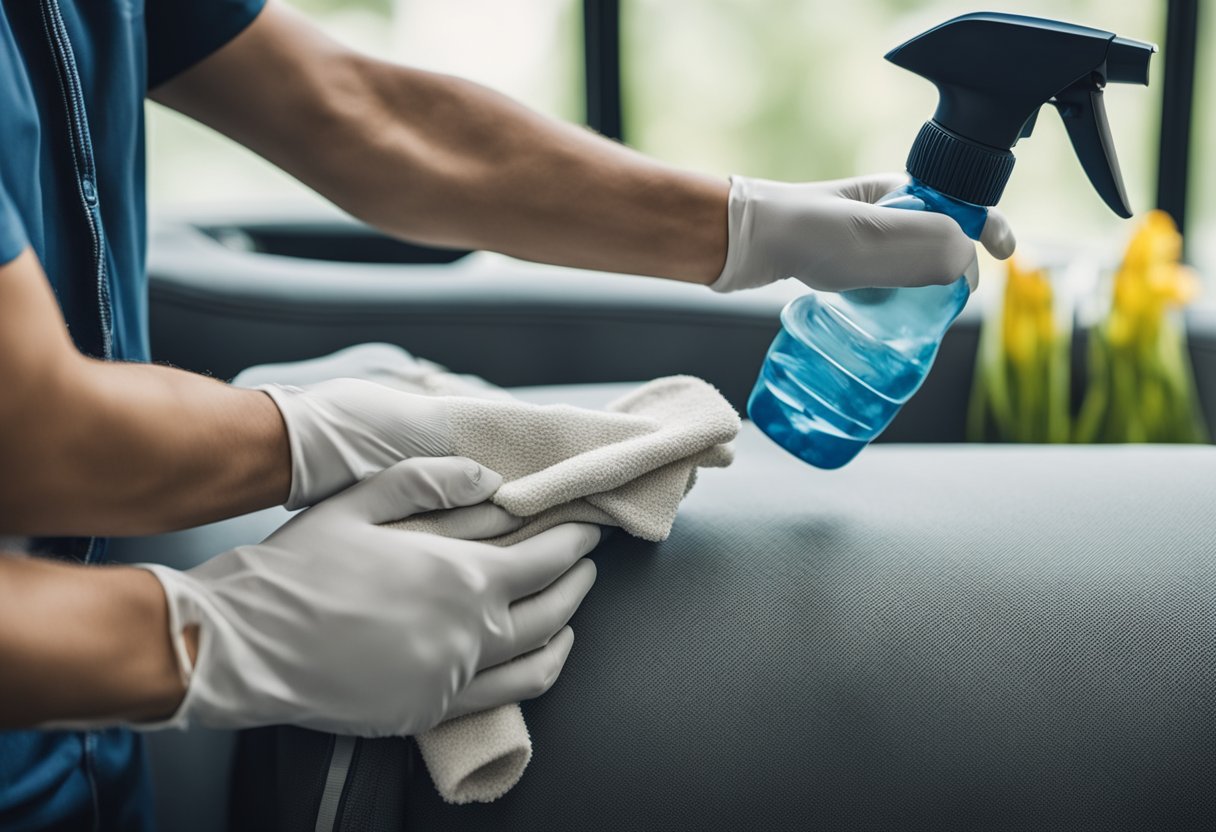Guide to Cleaning Cloth Car Upholstery: Tips and Tricks for a Spotless Interior
Car upholstery can easily accumulate dirt, stains, and odors, especially if you frequently use your vehicle. Cleaning cloth car upholstery is not only necessary for maintaining its appearance but also for ensuring a healthy and comfortable driving experience. However, many car owners are unsure of how to clean their car’s upholstery without causing damage. This guide will provide a step-by-step process for effectively cleaning and maintaining your car’s upholstery.

Understanding Upholstery Cleaning Basics Before diving into the cleaning process, it’s important to understand the basics of upholstery cleaning. Different types of fabrics require different cleaning methods and products. Using the wrong cleaner or technique can damage the upholstery and even void your car’s warranty. This guide will help you identify the type of fabric in your car and provide tips for selecting the right cleaner and cleaning method.
Key Takeaways
- Proper pre-cleaning preparation is essential for effective upholstery cleaning.
- Spot testing your cleaner before applying it to the entire upholstery is crucial to avoid damage.
- Regular maintenance and prompt stain removal can prolong the life of your car’s upholstery.
Understanding Upholstery Cleaning Basics

Cleaning cloth car upholstery can be a daunting task, but with the right knowledge and tools, it can be a breeze. Understanding the basics of upholstery cleaning is the first step towards achieving a clean and fresh interior.
The first thing to consider when cleaning upholstery is the type of fabric. Different fabrics require different cleaning methods and products. It is important to check the manufacturer’s instructions or seek professional advice before attempting to clean the upholstery.
Next, it is important to remove any loose dirt or debris from the upholstery before cleaning. This can be done using a vacuum cleaner or a soft-bristled brush. Removing loose dirt and debris will make the cleaning process more effective and prevent any damage to the fabric.
When it comes to cleaning products, it is important to use products that are specifically designed for upholstery. Using the wrong products can cause damage to the fabric or leave behind residue that can attract more dirt and debris.
It is also important to test any cleaning products on a small, inconspicuous area of the upholstery before using them on the entire surface. This will help to ensure that the product does not cause any damage or discoloration to the fabric.
In addition to cleaning products, there are also a variety of tools that can be used to clean upholstery, such as steam cleaners, upholstery brushes, and microfiber cloths. Using the right tools can make the cleaning process more effective and efficient.
By understanding the basics of upholstery cleaning, car owners can keep their interiors looking clean and fresh for years to come.
Pre-Cleaning Preparation

Gathering Necessary Supplies
Before starting the cleaning process, it is important to gather all the necessary supplies. This will save time and ensure that the cleaning process goes smoothly. Here are some of the supplies that are required for cleaning cloth car upholstery:
- Vacuum cleaner with attachments
- Soft-bristled brush
- Microfiber towels
- Upholstery cleaner
- Stain remover
- Bucket of warm water
It is important to note that the type of upholstery cleaner used should be suitable for the type of fabric on the car seats. It is recommended to test the cleaner on a small, inconspicuous area of the upholstery before using it on the entire seat.
Removing Large Debris and Personal Items
Before starting the cleaning process, it is important to remove any large debris and personal items from the car seats. This includes items such as trash, food crumbs, and personal belongings.
Using a soft-bristled brush or vacuum cleaner with attachments, gently remove any loose debris from the car seats. This will make the cleaning process more effective and prevent any damage to the upholstery.
Once all the large debris has been removed, it is important to remove any personal items such as jackets, bags, and other items from the car seats. This will prevent any damage to the items and ensure that the cleaning process is more effective.
By following these pre-cleaning preparation steps, the cleaning process for cloth car upholstery can be made easier and more effective.
Spot Testing Your Cleaner

Before applying any cleaner to your cloth car upholstery, it’s important to spot test it first. This will help you determine if the cleaner is safe to use and won’t cause any damage to the fabric.
To spot test your cleaner, follow these steps:
- Choose an inconspicuous area of the upholstery, such as the underside of the seat or a corner of the floor mat.
- Apply a small amount of the cleaner to a clean, white cloth.
- Gently rub the cloth onto the fabric in a circular motion.
- Check the cloth and the fabric for any discoloration, bleeding, or damage.
- If there is no damage or discoloration, you can proceed to clean the rest of the upholstery with the same cleaner.
It’s important to note that different types of fabric may react differently to the same cleaner. Therefore, it’s recommended to test the cleaner on each type of fabric in your car, such as leather, vinyl, or cloth.
By spot testing your cleaner, you can ensure that your cloth car upholstery stays clean and undamaged, giving your car a fresh and new look.
Stain Removal Techniques

Identifying Common Stains
Before applying any stain remover, it is important to identify the type of stain on your car upholstery. Different stains require different treatments, and using the wrong one can damage the fabric. Here are some common types of stains and how to identify them:
- Oil-based stains: These stains are greasy and don’t dissolve in water. They are usually caused by food, makeup, or body oils.
- Water-based stains: These stains are caused by spilled drinks or water. They are easy to clean and don’t leave a residue.
- Ink stains: Ink stains are caused by pens or markers. They are difficult to remove and require special treatment.
- Blood stains: Blood stains are caused by cuts or nosebleeds. They can be removed if treated immediately.
Applying Stain Removers
Once you have identified the type of stain, you can choose the appropriate stain remover. It is important to follow the instructions on the label and test the product on a small, inconspicuous area of the upholstery first. Here are some tips for applying stain removers:
- Apply the stain remover directly to the stain and let it sit for the recommended amount of time.
- Blot the stain with a clean cloth or paper towel to remove as much of the stain as possible.
- Rinse the area with water and blot dry.
Homemade Solutions
If you prefer to use natural or homemade solutions, there are several options for removing stains from car upholstery. Here are some effective homemade solutions:
- Baking soda and water: Mix equal parts baking soda and water to form a paste. Apply the paste to the stain and let it sit for 30 minutes. Rinse with water and blot dry.
- Vinegar and water: Mix equal parts white vinegar and water. Apply the solution to the stain and let it sit for 15 minutes. Rinse with water and blot dry.
- Club soda: Pour club soda directly onto the stain and let it sit for 10 minutes. Blot with a clean cloth or paper towel and rinse with water.
By following these stain removal techniques, you can keep your car upholstery looking clean and fresh.
Deep Cleaning Process

Vacuuming the Upholstery
Before deep cleaning the cloth upholstery, it is important to vacuum it thoroughly. This will remove any loose dirt, dust, or debris that may be on the surface of the fabric. Use a vacuum cleaner with a soft brush attachment to gently vacuum the upholstery. Make sure to get into all the crevices and corners of the seats, as well as the backrests and armrests.
Applying Upholstery Cleaner
Once the upholstery has been vacuumed, it is time to apply an upholstery cleaner. There are many different types of upholstery cleaners available, so it is important to choose one that is suitable for the type of fabric in your car. Read the instructions on the cleaner carefully before applying it to the upholstery.
Apply the cleaner to a small, inconspicuous area of the upholstery first to test for any adverse reactions. If there are no issues, apply the cleaner to the rest of the upholstery using a soft-bristled brush or sponge. Work in small sections, starting from the top of the seat and working your way down.
Scrubbing the Fabric
After the cleaner has been applied, use a soft-bristled brush or sponge to gently scrub the fabric. Pay special attention to any areas that are particularly dirty or stained. Be careful not to scrub too hard, as this can damage the fabric.
Rinsing and Drying
Once the upholstery has been scrubbed, it is time to rinse it thoroughly. Use a clean, damp cloth to wipe away any remaining cleaner from the fabric. Then, use a dry cloth to blot the upholstery and remove any excess moisture.
Allow the upholstery to air dry completely before using the car. Avoid using the car until the upholstery is completely dry, as this can cause mold or mildew to form.
Maintaining Your Car’s Upholstery

Regular Maintenance Tips
Keeping your car’s upholstery clean and well-maintained is essential to preserving its appearance and value. Regular maintenance can help prevent stains, odors, and other issues from developing. Here are some tips to keep your car’s upholstery in top condition:
- Vacuum regularly: Vacuuming your car’s upholstery at least once a week can help remove dirt, dust, and debris that can accumulate over time.
- Use a soft-bristled brush: When cleaning your car’s upholstery, use a soft-bristled brush to gently scrub away dirt and stains. Avoid using harsh chemicals or abrasive materials that can damage the fabric.
- Wipe up spills immediately: If you spill something on your car’s upholstery, be sure to wipe it up immediately. Use a clean, damp cloth to blot the area and remove as much of the stain as possible.
Dealing with Odors
Odors can be a common problem in cars, especially if you frequently transport pets or food. Here are some tips to help eliminate odors from your car’s upholstery:
- Use baking soda: Sprinkling baking soda on your car’s upholstery and letting it sit for a few hours can help absorb odors. Vacuum up the baking soda afterward.
- Use an odor eliminator: There are many commercial odor eliminators available that can help neutralize unpleasant smells in your car.
- Air out your car: Leaving your car’s windows open for a few hours can help circulate fresh air and eliminate odors.
Protecting Upholstery from Future Stains
Preventing stains from developing in the first place is the best way to keep your car’s upholstery looking clean and new. Here are some tips to help protect your car’s upholstery from future stains:
- Use seat covers: Installing seat covers can help protect your car’s upholstery from spills, stains, and other damage.
- Avoid eating and drinking in your car: Eating and drinking in your car can increase the risk of spills and stains. Try to avoid doing so whenever possible.
- Clean up spills immediately: As mentioned earlier, wiping up spills immediately can help prevent stains from setting in and damaging your car’s upholstery.
Troubleshooting Common Issues

When it comes to cleaning cloth car upholstery, there are a few common issues that may arise. Here are some troubleshooting tips to help you tackle these problems:
Stains
Stains are a common issue with cloth car upholstery. If you have a stain, it’s important to act quickly to prevent it from setting in. Blot the stain with a clean cloth or paper towel to remove as much of the liquid as possible. Then, use a specialized upholstery cleaner or a mixture of water and mild detergent to clean the stain. Be sure to test the cleaner on a small, inconspicuous area first to make sure it doesn’t cause any discoloration or damage to the fabric.
Odors
If your car upholstery has an unpleasant odor, there are a few things you can do to eliminate it. First, vacuum the upholstery thoroughly to remove any debris or dirt that may be causing the odor. Then, sprinkle baking soda over the upholstery and let it sit for several hours. Vacuum up the baking soda and repeat as necessary. You can also use a specialized upholstery cleaner that is designed to eliminate odors.
Fading
Fading is a common issue with cloth car upholstery, especially if the car is parked in direct sunlight for extended periods of time. To prevent fading, park in a shaded area or use a car cover. If your upholstery has already faded, there’s not much you can do to restore the color. However, you can use a fabric dye to give the upholstery a new color.
By following these troubleshooting tips, you can keep your cloth car upholstery looking clean and fresh.
Frequently Asked Questions

What are the most effective methods to clean fabric car seat stains?
The most effective methods to clean fabric car seat stains depend on the type of stain. For instance, vinegar and baking soda work well on food and drink stains, while a mixture of dish soap and warm water can be used to remove grease and oil stains. However, it’s important to test any cleaning solution on an inconspicuous area of the fabric before applying it to the stain.
Can I deep clean my cloth car seats using household products?
Yes, you can deep clean your cloth car seats using household products. For example, a mixture of vinegar, baking soda, and hot water can be used to deep clean the fabric. It’s important to vacuum the seats thoroughly before applying any cleaning solution to remove any loose dirt or debris.
How can I clean my fabric car seats without leaving water stains?
To clean fabric car seats without leaving water stains, it’s important to use as little water as possible. A mixture of rubbing alcohol and water can be used to clean the fabric without leaving any water stains. It’s also important to dry the seats thoroughly after cleaning them to prevent any water stains from forming.
What is the best cloth or tool to use when cleaning car seats?
The best cloth or tool to use when cleaning car seats depends on the type of fabric. Microfiber cloths are effective for cleaning most types of fabric, while a soft-bristled brush can be used to clean more delicate fabrics. It’s important to avoid using abrasive cloths or brushes, as they can damage the fabric.
How do you effectively clean fabric car seat covers?
To effectively clean fabric car seat covers, it’s important to remove them from the car and wash them separately. Use a gentle detergent and cold water to avoid damaging the fabric. It’s also important to avoid using bleach or fabric softeners, as they can damage the fabric.
What techniques work best for cleaning the interior fabric roof of a car?
To clean the interior fabric roof of a car, it’s important to use a gentle cleaning solution and a soft-bristled brush. A mixture of warm water and dish soap can be used to clean the fabric without damaging it. It’s important to avoid using abrasive brushes or cleaning solutions, as they can damage the fabric.






